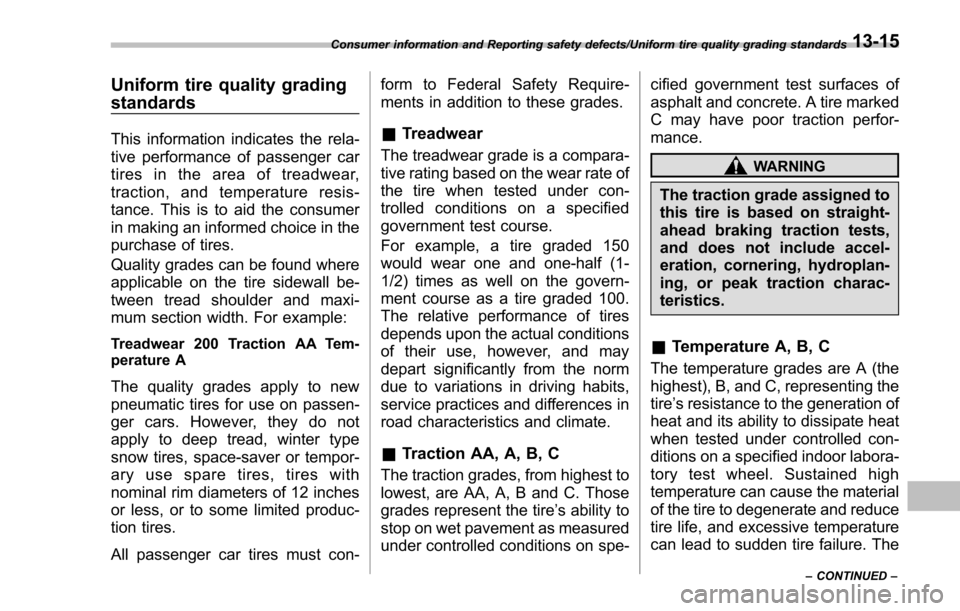2016 SUBARU IMPREZA spare tire
[x] Cancel search: spare tirePage 549 of 594

Specifications/Specifications
&Tires
! U.S.-spec. models and Canada-spec. models
Tire size P195/65R15 89H P205/55R16 89V P205/50R17 88V P225/55R17 95H
Wheel size 1566J 1666
1/2J 17
67 JJ*1
17 67J*217 67J
Pressure Front 35 psi (240 kPa, 2.4 kgf/cm
2) 32 psi (220 kPa, 2.2 kgf/cm2)CVT models 33 psi (230 kPa, 2.3 kgf/cm2)
MT models 32 psi (220 kPa, 2.2 kgf/cm2)
Rear 33 psi (230 kPa, 2.3 kgf/cm
2) 30 psi (210 kPa, 2.1 kgf/cm2)CVT models 32 psi (220 kPa, 2.2 kgf/cm2)
MT models 30 psi (210 kPa, 2.1 kgf/cm2)
Temporary
spare tire Size T135/80 D16 T145/90 D16
Pressure
60 psi (420 kPa, 4.2 kgf/cm
2)
Wheel nut tightening
torque 89 lbf·ft (120 N·m, 12 kgf·m)*
3
*1:
“SPORT ”and “SPORT-Ltd ”models
*2: Other vehicle models
*3: This torque is equivalent to applying approximately 88 to 110 lbf (40 to 50 kgf) at the end of the wheel nut wrench. If you have tightened the wheel
nuts by yourself, have the tightening torque checked at the nearest automotive service facility as soon as possible. For the wheel nut tightening
procedure, refer to “Changing a flat tire ”F 9-6.
12-8
Page 550 of 594

!Other models
Tire size P205/55R16 89VP205/50R17 88V225/55R17 97V
Wheel size 1666 1/2 J 1767J 1767J
Pressure Front 35 psi (240 kPa, 2.4 kgf/cm
2) 32 psi (220 kPa, 2.2 kgf/cm2) 32 psi (220 kPa, 2.2 kgf/cm2)
Rear 33 psi (230 kPa, 2.3 kgf/cm2) 30 psi (210 kPa, 2.1 kgf/cm2) 30 psi (210 kPa, 2.1 kgf/cm2)
Temporary spare
tire Size
P205/55R16 P205/50R17185/65R17
Pressure 35 psi (240 kPa, 2.4 kgf/cm
2) 32 psi (220 kPa, 2.2 kgf/cm2) 42 psi (290 kPa, 3.0 kgf/cm2)
Wheel nut tightening torque 73.8 lbf·ft (100 N·m, 10.2 kgf·m)
&
Brake disc
If you need information on the usage limit value of brake discs and the method for measuring them, we recommend that you consult
your SUBARU dealer.
Specifications/Specifications12-9
Page 564 of 594

crease in temperature could cause
tread separation, and failure of the
tire(s). Possible resulting loss of
vehicle control could lead to an
accident.
!Measuring and adjusting air
pressure to achieve proper in-
flation
Check and, if necessary, adjust the
pressure of each tire (including the
spare) at least once a month and
before any long journey. Check the
tire pressures when the tires are
cold. Use a pressure gauge to
adjust the tire pressures to the
specific values. Driving even a
short distance warms up the tires
and increases the tire pressures.
Also, the tire pressures are affected
by the outside temperature. It is
best to check tire pressure out-
doors before driving the vehicle.
When a tire becomes warm, the air
inside it expands, causing the tire
pressure to increase. Be careful not
to mistakenly release air from a
warm tire to reduce its pressure.
&Glossary of tire terminology
.Accessory weight
The combined weight (in excess of
those standard items which may be
replaced) of automatic transmis-
sion, power steering, power brakes,
power windows, power seats, radio,
and heater, to the extent that these
items are available as factory-in-
stalled equipment (whether in-
stalled or not).
.Bead
The part of the tire that is made of
steel wires, wrapped or reinforced
by ply cords and that is shaped to fit
the rim.
.Bead separation
A breakdown of the bond between
components in the bead.
.Bias ply tire
A pneumatic tire in which the ply
cords that extend to the beads are
laid at alternate angles substantially
less than 90 degrees to the center-
line of the tread.
.Carcass
The tire structure, except tread and sidewall rubber which, when in-
flated, bears the load.
.Chunking
The breaking away of pieces of the
tread or sidewall.
.Cold tire pressure
The pressure in a tire that has been
driven less than 1 mile or has been
standing for three hours or more.
.Cord
The strands forming the plies in the
tire.
.Cord separation
The parting of cords from adjacent
rubber compounds.
.Cracking
Any parting within the tread, side-
wall, or inner liner of the tire
extending to cord material.
.Curb weight
The weight of a motor vehicle with
standard equipment including the
maximum capacity of fuel, oil and
coolant, and if so equipped, air
conditioning and additional weight
optional engine.
Consumer information and Reporting safety defects/Tire information
–CONTINUED –13-5
Page 574 of 594

Uniform tire quality grading
standards
This information indicates the rela-
tive performance of passenger car
tires in the area of treadwear,
traction, and temperature resis-
tance. This is to aid the consumer
in making an informed choice in the
purchase of tires.
Quality grades can be found where
applicable on the tire sidewall be-
tween tread shoulder and maxi-
mum section width. For example:
Treadwear 200 Traction AA Tem-
perature A
The quality grades apply to new
pneumatic tires for use on passen-
ger cars. However, they do not
apply to deep tread, winter type
snow tires, space-saver or tempor-
ary use spare tires, tires with
nominal rim diameters of 12 inches
or less, or to some limited produc-
tion tires.
All passenger car tires must con-form to Federal Safety Require-
ments in addition to these grades.
&
Treadwear
The treadwear grade is a compara-
tive rating based on the wear rate of
the tire when tested under con-
trolled conditions on a specified
government test course.
For example, a tire graded 150
would wear one and one-half (1-
1/2) times as well on the govern-
ment course as a tire graded 100.
The relative performance of tires
depends upon the actual conditions
of their use, however, and may
depart significantly from the norm
due to variations in driving habits,
service practices and differences in
road characteristics and climate.
&Traction AA, A, B, C
The traction grades, from highest to
lowest, are AA, A, B and C. Those
grades represent the tire ’s ability to
stop on wet pavement as measured
under controlled conditions on spe- cified government test surfaces of
asphalt and concrete. A tire marked
C may have poor traction perfor-
mance.
WARNING
The traction grade assigned to
this tire is based on straight-
ahead braking traction tests,
and does not include accel-
eration, cornering, hydroplan-
ing, or peak traction charac-
teristics.
&
Temperature A, B, C
The temperature grades are A (the
highest), B, and C, representing the
tire ’s resistance to the generation of
heat and its ability to dissipate heat
when tested under controlled con-
ditions on a specified indoor labora-
tory test wheel. Sustained high
temperature can cause the material
of the tire to degenerate and reduce
tire life, and excessive temperature
can lead to sudden tire failure. The
Consumer information and Reporting safety defects/Uniform tire quality grading standards
–CONTINUED –13-15
Page 587 of 594

14-10Index
Steering switches for audio......................................... 5-63
Steering wheel Power ................................................................... 7-30
Tilt/telescopic ........................................................ 3-110
Stop light ................................................................. 11-38
Storage compartment ................................................... 6-5
Sun shade ................................................................ 2-44
Sun visors ................................................................... 6-4
Supplemental Restraint System airbag (SRS) ................ 1-39
Synthetic leather upholstery ........................................ 10-5
T
Tachometer ............................................................... 3-11
Temperature warning light AT OIL TEMP ........................................................ 3-19
Coolant ................................................................. 3-17
Temporary spare tire .................................................... 9-2
Tether (child restraint system) .............................. 1-33, 1-36
Tie-down hooks/holes ................................................. 9-14
Tire ................................................................. 11-21, 12-8 Chains .................................................................. 8-11
Inspection ............................................................ 11-23
Pressures and wear .............................................. 11-23
Replacement ........................................................ 11-27
Rotation ............................................................... 11-26
Size and pressure .................................................. 12-8
Types .................................................................. 11-21
Tire pressure monitoring system (TPMS). ...... 7-38, 9-9, 11-21
Warning light ......................................................... 3-19
Tires and wheels. ...................................................... 11-21
Tools ........................................................................\
.. 9-3 Top tether anchorages
........................................ 1-33, 1-36
Towing ...................................................................... 9-14
All wheels on the ground ......................................... 9-17
Flat-bed truck ......................................................... 9-16
Hooks ................................................................... 9-14
Weight .................................................................. 8-19
Trailer Connecting ............................................................ 8-17
Hitch ............................................................. 8-16, 8-22
Towing .................................................................. 8-18
Towing tips ............................................................ 8-24
Trip meter .................................................................. 3-11
Trunk lid .................................................................... 2-38
Release handle ...................................................... 2-39
Trunk light ............................................................... 11-43
Turn signal
Indicator lights ........................................................ 3-31
Lever .................................................................... 3-92
U
Under-floor storage compartment .................................. 6-15
V
Valet mode ................................................................ 2-32
Vanity mirror ............................................................... 6-5
Vehicle
Capacity weight ...................................................... 8-13
Identification ........................................................ 12-17
Symbols ....................................................................
3